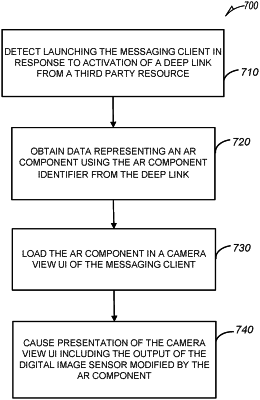| CPC H04L 67/131 (2022.05) [G06T 7/70 (2017.01); G06T 7/97 (2017.01); G06T 19/006 (2013.01); H04L 67/01 (2022.05)] | 20 Claims |

|
1. A method comprising:
configuring an augmented reality component to apply a modification to a media content object, the augmented reality component identified by an augmented reality component identifier;
receiving a request for a deep link to the augmented reality component;
in response to the request, constructing the deep link, the deep link including:
an address for a client application; and
the augmented reality component identifier;
making the deep link available to a third party resource executing at a client device;
detecting launching of the client application at the client device in response to activation of the deep link from the third party resource, the third party resource configured to provide a third party resource user interface comprising a user selectable element to activate the deep link;
in response to the detecting, using the augmented reality component identifier from the deep link to obtain data representing the augmented reality component;
using the data representing the augmented reality component, causing the augmented reality component to load in a camera view user interface of the client application at the client device, the camera view user interface including output of a digital image sensor of a camera of the client device, the loading comprising applying the modification to the output of a digital image sensor, the camera view user interface being different from the third party resource user interface;
causing presentation of the camera view user interface at the client device, the presentation comprising the output of the digital image sensor modified by the augmented reality component;
detecting a request at the client application to share content comprising the output of the digital image sensor modified by the augmented reality component;
generating shared content by including, with the content, a reference identifying the third party resource; and
communicating the shared content to a further computing device.
|